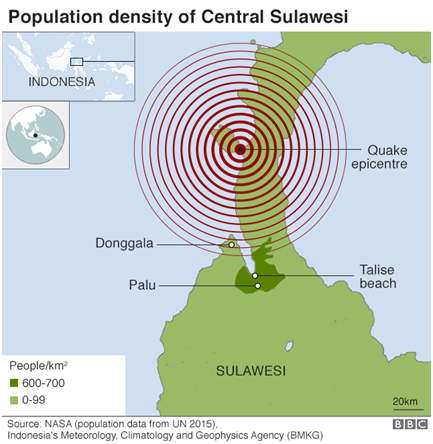Earthquake in Indonesia
By Rashi AgarwalIndonesia is a Southeast Asian country made up of thousands of volcanic islands.
On Friday, 28th September 2018, a 7.5 magnitude quake occurred at a depth of 10 kms just off the central island of Sulawesi.
The earthquake was powerful but shallow and with more lateral than vertical movement, not typically the kind of tremor that sets off tsunamis. A sophisticated tsunami warning system was put in place across the whole Pacific region after the 2004 disaster, which killed nearly 2.5 lakh people.
A tsunami warning was issued after the earthquake hit on Friday, but many people in Palu did not receive alerts because of power cuts caused by the tremor. There were also no sirens located along the coast.
This led to a great disaster as it is a densely populated region. The official death toll from the earthquake and tsunami in Indonesia has risen to 844, but thousands more are feared dead as aid workers continue to struggle to reach the worst hit areas. The bodies of some of the victims have been buried in a mass grave near Palu. At least 600 people wounded in the disaster are being treated in hospital. More than 48,000 have been forced to leave their homes.
Electricity is still down in the affected region, hampering rescue efforts, and there is a major shortage of fuel. Queues at petrol stations around Palu reportedly stretch for kilometers. The International Committee of Red Cross says 178 of its aid workers are on the ground in the area.
Thousands of people have tried to flee Palu via the city’s airport. Only one flight a day is due to leave. More than 1,400 prisoners are missing from a local jails in the area.
Apart from these numbers, there may still be hundreds buried under all the debris, which will take days for the rescue team to reach.
The archipelago of Indonesia lies in the Pacific Ring of Fire, a region prone to earthquakes and volcanic eruptions.





